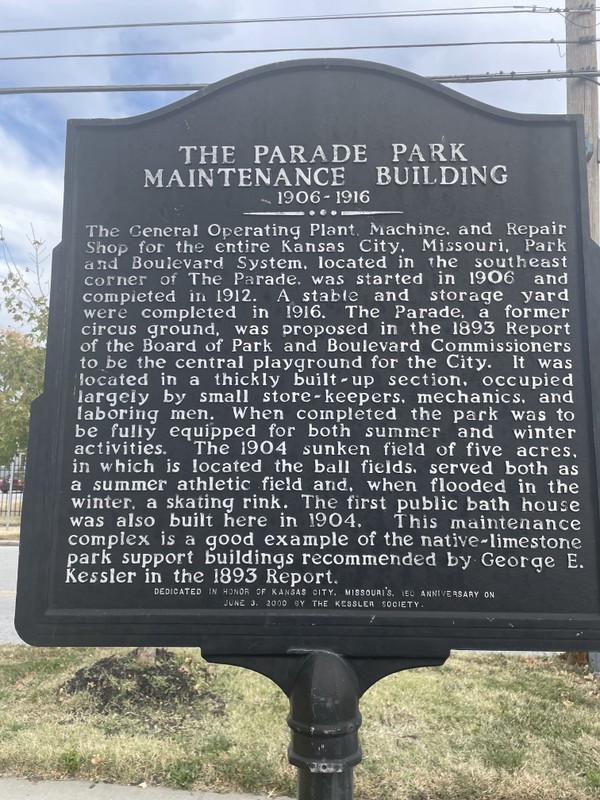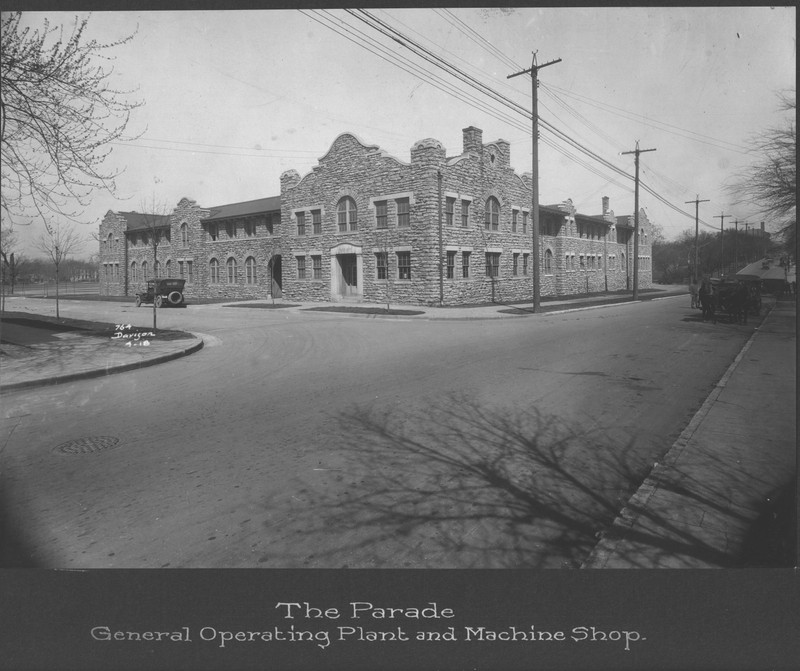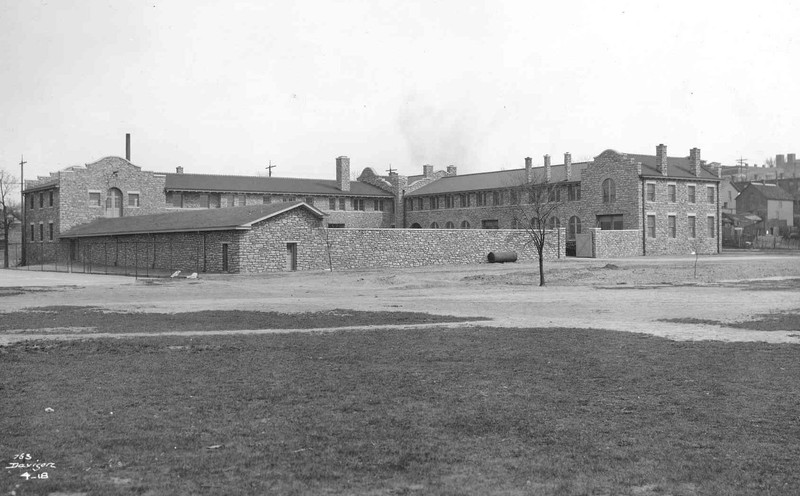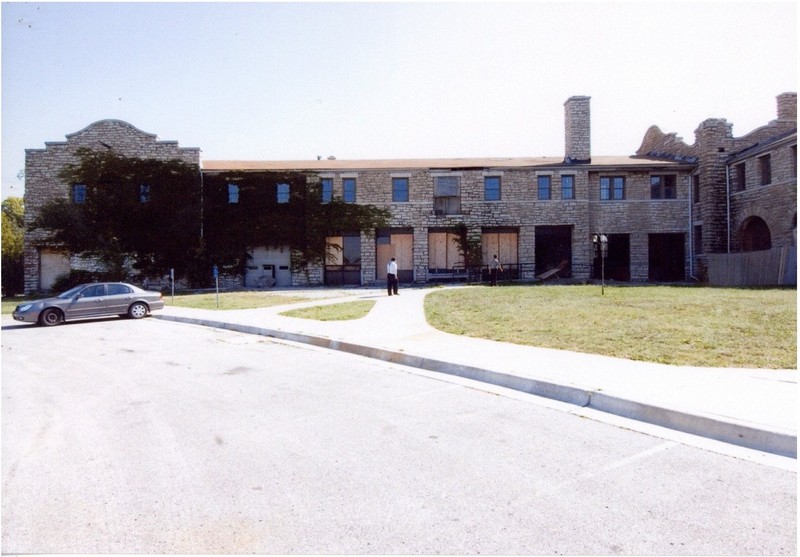Parade Park Maintenance Building Historical Marker
Introduction
Text-to-speech Audio
This historical marker shares the history of one of the oldest remaining buildings in the area. Constructed in 1912 and filling one corner of the recreation area known as the Parade, this stone structure was completed after the initial commercial and residential development of the area. The building housed numerous parts of Kansas City's new Parks Department, including horses and horse care facilities, horse-drawn equipment used to maintain the park, and a machine/repair shop, as well as storage, toilet facilities, and a garage for vehicles. The initial structure formed a rectangle, with a wall extending out from the west end of the building and a third wing extending from the end of the north wing, forming a rectangular courtyard. Though only the north and west wings of the building remain today, the building continues to serve the Kansas City area as the location for the Black Archives of Mid-America, which moved from a historic fire station nearby to the previously-unoccupied building in 2012. Though Parade Park has changed significantly due to the construction of the Gregg/Klice Community Center and the Kansas City MLB Urban Youth Academy, the Parade Park Maintenance Building continues to serve as an anchor for the area.
Images
This historical marker is located on the east side of the building

A picture of the Parade Park Maintenance Building, taken looking northwest on what is now Woodland Ave

A picture of the Parade Park Maintenance Building from the southeast. In front of the building, the now-removed wall and wing can be seen.

A picture of the Parade Park Maintenance Building prior to renovation. Date unknown, likely before 2012.

Backstory and Context
Text-to-speech Audio
According to a history of the site provide on an application for the National Register of Historic Places, the genesis of the Parade Park Maintenance Building came in 1892, when advocacy by William Rockhill Nelson resulted in the establishment of the Board of Parks and Boulevard Commissioners. Landscape architect George Kessler was hired to develop a plan for "a series of recreational parks linked by vehicular boulevards." As part of this plan, Kessler included a plan for a large flat area that could be used for both civic purposes and as a military drilling and marching ground, citing such an area as an "obvious need" for the rapidly-growing city. The Parks Board selected an area known as the Gates & Kendall Tract for this purpose, as the land was centrally located in the city, surrounded by middle- and working-class homes, and already in use for public events that required a large space.
As the tract was developed, a portion of the western side was developed into a section of the Paseo. As the park was developed, maintenance facilities developed along with it. By 1909, several smaller buildings housed the storage facilities, stables, and other maintenance areas that the park needed to function. In 1912, however, city officials concluded that a more permanent and consolidated structure was necessary to keep up with the demands of park maintenance. Designed by architect Arthur L. Sparks, the new building would be situated in the southeast corner of Parade Park, and constructed of local limestone quarried nearby. The building housed a great deal of Parks Department equipment, including horses and horse care facilities, horse-drawn equipment used to maintain the park, and a machine/repair shop, as well as storage, toilet facilities, and a garage for motor vehicles. The initial structure formed a rectangle, with a wall extending out from the west end of the building and a third wing extending from the end of the north wing, forming a rectangular courtyard. The building continued to serve the Parks and Boulevard System through the 1960s, becoming a district headquarters to oversee one of the older segments of Kansas City parkland. The building was first earmarked for inclusion in the National Register of Historic Places in 1989, as it was "representative of the limestone park buildings in Kansas City." According to the registration information from the National Register of Historic Places, the Parade Park Maintenance Building is constructed in a Mission Revival style, which rose to prominence during the 1893 World's Columbia Exhibition in Chicago. The documents state that Kessler selected this design to keep the building harmonious with the surrounding parkland.
In recent years, the usage of the Parade Part Maintenance Building has shifted. At some unknown point within the last thirty to forty years, the Parks Department moved out of the building, letting it remain empty for several years. In 2012, the Black Archives of Mid-America took over the space, opening a permanent museum exhibit, gift shop, archival space, and other flexible venues in a retouched building. Even as the area has shifted around it, the Parade Park Maintenance Building has continued to serve as an anchor point of the surrounding parklands.
Sources
National Register of Historic Places, Parade Park Maintenance Building, Kansas City, Jackson County, MO, National Register #08000719
Photo by David Trowbridge
Kansas City, Missouri Parks and Recreation Department Archives
Kansas City, Missouri Parks and Recreation Department Archives
The Black Archives of Mid-America
